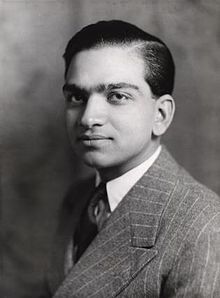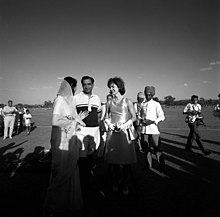Man Singh II
| Man Singh II | |
|---|---|
 Man Singh II at an early age | |
| Maharaja of Jaipur | |
| Reign | 1922–1948 |
| Coronation | 18 September 1922 |
| Predecessor | Sawai Madho Singh II |
| Successor | Sawai Bhawani Singh |
| Titular Reign | 1948–1970 |
| Born | Mor Mukut Singh 21 August 1912 Thikana of Isarda,Rajputana Agency,British India |
| Died | 24 June 1970(aged 57) Cirencester,England,United Kingdom |
| Consort(s) | Princess Marudhar Kanwar of Marwar Princess Kishore Kanwar of Marwar Princess Gayatri Devi of Cooch Behar |
| Issue | Prem Kumari Singh Sawai Bhawani Singh Sawai Jai Singh III Sawai Prithviraj Singh Sawai Jagat Singh |
| House | Kachwaha |
| Father | Sawai Singh(biological) Sir Sawai Madho Singh II(adoptive) |
| Mother | Sugun Kunwar Singh(biological) |
| Religion | Hinduism |
| RajpramukhofRajasthan | |
| In office 30 March 1949 – 31 October 1956 | |
| Preceded by | Bhupal Singh |
| Succeeded by | position abolished Gurmukh Nihal Singh(asGovernor of Rajasthan) |
| Ambassador of India to Spain | |
| In office 1965 – 1970[1] | |
Major GeneralMaharajaSawaiGovernor SirMan Singh IIGCSIGCIE(bornSawaiMor Mukut Singh;21 August 1912 – 24 June 1970) was an Indianprince,government official, diplomat and sportsman.
Man Singh II was the rulingMaharajaof theprincely stateofJaipurin theBritish Rajfrom 1922 to 1947. In 1948, after the state wasabsorbedinto independent India, he was granted aprivy purse,certain privileges, and the continued use of the titleMaharaja of Jaipurby theGovernment of India,[2]which he retained until his death in 1970. He also held the office ofRajpramukh(Governor) ofRajasthanbetween 1949 and 1956. In later life, he served as Ambassador of India to Spain. He was a notablepoloplayer.[citation needed]
Early life[edit]
Sawai Man Singh II, was born Mor Mukut Singh, the second son ofThakurSawai Singh of Isarda by his wife Sugan Kunwar, a lady from Kotla village inUttar Pradesh.His father was a nobleman belonging to theKachhwahaclan. Mor Mukut grew up in the dusty, walled township of Isarda, a chief ofthikanaof the Rajawat sub-clan which lies between the towns ofSawai Madhopurand Jaipur in present-day Rajasthan. His family was connected to the ruling house of Jaipur andKotah(where his father's sister was married). The then-Maharaja of Jaipur, SawaiMadho Singh II,had been born the son of a former Thakur of Isarda and had been adopted into the ruling family of Jaipur. After giving him up for adoption, Madho Singh's actual father had in turn lacked for an heir. He adopted the son of a distant kinsman and was succeeded by that lad as Thakur of Isarda. That lad was Sawai Singh, father of Mor Mukut Singh. In this manner, Mor Mukut could be reckoned near kin to Maharaja Madho Singh II of Jaipur.[citation needed]
After being adopted to become Maharaja of Jaipur, Madho Singh II had numerous (no less than 65) children by various concubines, but the highly superstitious Maharaja was warned by a sage against having legitimate heirs and thus took great care not to impregnate his five wives. On 24 March 1921, Madho Singh II adopted Mor Mukut to be his son and heir. The boy was given the name "Man Singh" upon his adoption. Madho Singh II died on 7 September 1922 and was succeeded by Man Singh as Maharaja of Jaipur and head of the Kachwaha clan of Rajputs. The new Maharaja was ten years old.[citation needed]
Maharaja of Jaipur[edit]
Upon obtaining his ruling powers, Man Singh embarked on a programme of modernisation, creating infrastructure and founding numerous public institutions that would later result in Jaipur being selected the capital of Rajasthan. At the time of the Independence ofBritish Indiain 1947, the maharaja delayed acceding Jaipur to theDominion of India.He finally signed anInstrument of Accessionin April 1949, when his princely state became part of the Rajasthan States Union, initially retaining his powers of internal government. The Maharaja becameRajpramukhof the States Union, but the office was abolished when the Indian states were further re-organised in 1956. Although the Indian princes had by then relinquished their ruling powers, they remained entitled to their titles, privy purses, and other privileges until the adoption of the 26th amendment to theConstitution of Indiaon 28 December 1971. Accordingly, Man Singh II remained Maharaja of Jaipur until his death.[3]
In 1958, Man Singh was one of several rulers who realised the potential oftourismin Rajasthan, turningRambagh Palaceinto a luxury hotel. Under his rule, various land reform laws were first introduced in his state, such as the Jaipur Tenancy Act. Later in 1956, theJagidari(feudal) form of political administration were abolished during the government of the Congress Party in India. In 1962 he was elected to Council of States, the Rajya Sabha the Upper House of Indian Parliament with term till 1968,[4]however in 1965, the Indian government appointed Man Singh as India's ambassador to Spain. Utilising his various contacts in Europe, he spent much of his time in Europe to ensue new military technology and arms deal for the Indian army (Crewe).
He was especially noted as an enthusiastic (10-Goal)poloplayer, winning among other trophies the World Cup in 1933. TheSawai Mansingh StadiuminJaipuris named in his honour. During the 1950s, Man Singh ownedSaint Hill ManorinEast Grinstead,West Sussex,which was sold toL. Ron Hubbard,founder ofScientologyin 1959.[5]
Personal life[edit]


Marriages[edit]
Man Singh II was married three times, and his three wives lived in the same household together, in accordance with Rajput custom. His first two marriages were to suitable brides chosen from the royal family ofJodhpur,whose Rajput heritage and social ranking were similar to his own. The senior Maharani, known within the palace as 'First her Highness,' was Marudhar Kunwar, sister ofSumer Singh,Maharaja ofJodhpur.She was about twelve years older than him and bore him two children: first a daughter, Prem Kumari, and then his eldest son and heir,Bhawani Singh.His second wife was Maharani Kishore Kanwar, niece of his first wife and daughter of Maharaja Sumer Singh of Jodhpur. She was five years younger than he and bore him two sons.
He was briefly involved with English socialiteLady Ursula Manners.[6][7]
In 1940, Man Singh II married for the third and last time. His bride was the legendary beautyGayatri Devi of Cooch Behar,the daughter of MaharajaJitendra NarayanofCooch Beharand MaharaniIndira Devi,princess of Baroda. She stands out among the Maharanis of Jaipur for having become a public figure and a celebrity of sorts, initially for being a fashion-conscious beauty and later for becoming a politician and parliamentarian. They had one son. Devi survived him by thirty-nine years, dying in 2009.
Children[edit]
Man Singh was the father of four sons and a daughter, borne to him by his three wives. They were:
- By his first wife, Maharani Marudhar Kunwar, one son and one daughter
- Prem Kumari (1929–1970). In 1948, she was given in marriage to the Maharawal ofBaria.She had one daughter.
- Bhawani Singh(1931–2011), succeeded to his father's title in 1970. In 1967, he married Padmini Devi, daughter of the Raja ofSirmur,and had one daughter;
- Diya Kumari(b. 1970). She has three children, including one son who was adopted by Bhawani Singh and declared his successor, namely:
- Padmanabh Singh(b. 1998).[8]Born a commoner, he was declared royal and adopted by his maternal grandfather in 2002.
- Diya Kumari(b. 1970). She has three children, including one son who was adopted by Bhawani Singh and declared his successor, namely:
- By his second wife, Maharani Kishore Kunwar, two sons
- Jai Singh (b. 1933). he was given the title of Raja ofJhalaiand the estate of Jhalai in appanage by his father. In 1983, he married Vidya Devi, daughter of the Raja of Jubbal, and has one son.
- Ajay Singh
- Prithviraj (1935–2020); received the title Raja of Bhagwatgarth. In 1961, he married Devika Devi, a princess of Tripura and a niece (sister's daughter) of his step-mother Gayatri Devi. They had been living separately from each other by the time she died in 2009, a few months before her aunt. Gayatri Devi tended to support her step-son and deprecate her niece in the matter of their marital differences, and Prithviraj Singh remained close to his step-mother all his life.[9]Prithviraj and Devika had one son together:
- Vijit Singh, who in 1991 married Minakshi Devi, daughter of the Maharaja of Lunawada, and has three children; two sons named Vedant Singh (b. 1992) and Siddhant Singh (b. 1996), and a daughter Mokshita (b. 1993).
- By his third wife, Gayatri Devi (1919–2009)[10]
- Prince Jagat Singh, (1949–1997) received the title Raja of Isarda was married in 1978 (divorced 1987) to a Thai princess. He had two children by her, namely,
- Lalitya Kumari (b. 1979), daughter
- Devraj Singh, (b. 1981), son
Death[edit]

In 1970, Man Singh had an accident while playing polo inCirencester,England. He died later the same day. He was survived by his four sons. He was succeeded as Maharaja of Jaipur and head of the Kachwaha clan by his eldest son, Maharaja SawaiBhawani Singh of Jaipur.Following his deathIndira Gandhiwas finally able to repress the power of India's former rulers in democratic India as they formed a large bulk of her opposition party, theSwatantra party.
A statue of Sawai Man Singh was installed at the Ram Niwas Bagh in Jaipur, the statue was unveiled at a grand function on 30 March 2005.[10]A Cricket Stadium in Jaipur was named after him. His wife Gayatri Devi opened a school after him, Maharaja Sawai Man Singh Vidyalaya.
His successor, Maharaja SawaiBhawani Singh of Jaipurdied on 17 April 2011, aged 79.
See also[edit]
References[edit]
- ^Taknet, D. K.(7 July 2016).Jaipur: Gem of India.ISBN9781942322054.
- ^Ramusack, Barbara N.(2004).The Indian princes and their states.Cambridge University Press. p. 273.ISBN978-0-521-26727-4.
The crucial document was the Instrument of Accession by which rulers ceded to the legislatures of India or Pakistan control over defence, external affairs, and communications. In return for these concessions, the princes were to be guaranteed a privy purse in perpetuity and certain financial and symbolic privileges such as exemption from customs duties, the use of their titles, the right to fly their state flags on their cars, and to have police protection.... By December 1947 Patel began to pressure the princes into signing Merger Agreements that integrated their states into adjacent British Indian provinces, soon to be called states or new units of erstwhile princely states, most notably Rajasthan, Patiala and East Punjab States Union, and Matsya Union (Alwar, Bharatpur, Dholpur and Karaulli).
- ^Careers Digest,Vol. 7 (1970), p. 488: Swai Man Singh: The Maharaja of Jaipur State who died in London recently at the age-of 59, was the 39th ruler of the Jaipur State. A progressive statesman, he was the last Indian Maharaja to sign the Instrument of Accession. He was the Rajpramukh of Rajasthan from April 7, 1949 to October 1956. "
- ^"SINGH, SHRI SAWAI MAN – RAJYA SABHA MEMBERS BIOGRAPHICAL SKETCHES 1952 – 2003"(PDF).Rajya Sabha Secretariat. p. 34.Retrieved21 November2017.
- ^"Visit Historic Saint Hill Manor".Saint Hill Manor.Retrieved27 December2013.
- ^d'Abo 2014,p. 99.
- ^"Londoner's Diary: Alexa's Chung's neighbours make Christmas shopping tricky..."London Evening Standard.7 November 2017.Retrieved29 July2018.
- ^Colacello, Bob."Inside Paris's 25th Annual le Bal des Débutantes".Vanity Fair.
- ^Talukdar, Rakhee."Royals won't tell what Gayatri will holds".Saint Hill Manor.Archived fromthe originalon 12 September 2012.Retrieved27 December2013.
- ^abSharma, Abha."The people's princess".Deccan Herald.Retrieved27 December2013.
Works cited[edit]
- d'Abo, Lady Ursula (2014). Watkin, David (ed.).The Girl with the Widow's Peak: The Memoirs.London: d'Abo Publications.ISBN978-1907991097.
- Knights Grand Commander of the Order of the Star of India
- Knights Grand Commander of the Order of the Indian Empire
- 1912 births
- 1970 deaths
- 20th-century Indian monarchs
- Indian polo players
- Accidental deaths in England
- Sport deaths in England
- Polo deaths
- Ambassadors of India to Spain
- People from Jaipur
- Maharajas of Jaipur
- Indian knights
- Indian Hindus
- Rajpramukhs
- Polo players from Rajasthan
- Rajya Sabha members from Rajasthan
- Indian Army personnel
- 20th-century Indian military personnel
